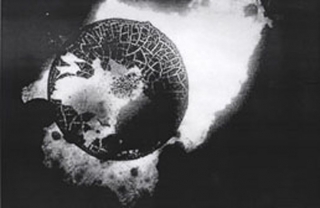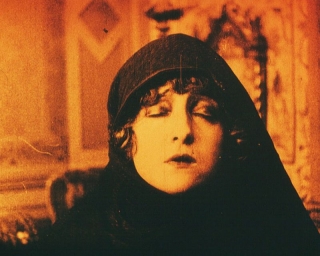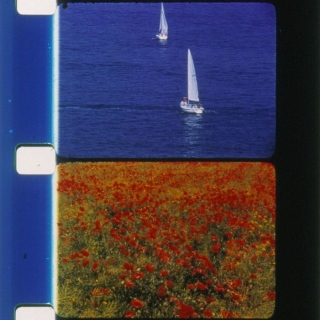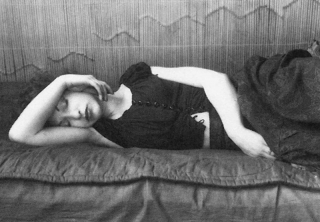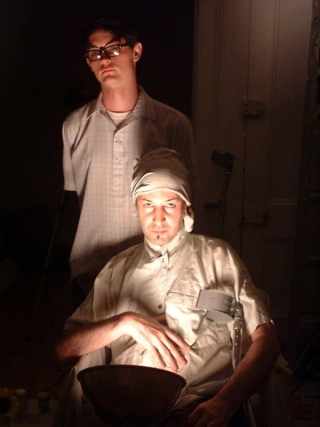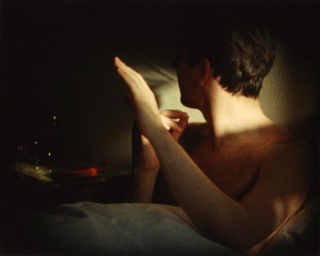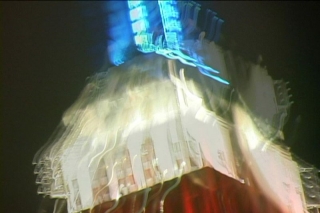Date: 9 November 2002 | Season: London Film Festival 2002 | Tags: London Film Festival
WITHIN THE REALMS OF ABSTRACTION
Saturday 9 November 2002, at 12pm
London National Film Theatre NFT3
Fred Worden, Automatic Writing 2, USA, 2000, 12 min
Negotiating the mysterious zone where light and no-light flutter in a fecund equipoise: A home-made rocket to realms unknown to any movie camera or photo lens.
Richard Reeves, 1:1, Canada, 2001, 5 min
Cameraless animation about the 1:1 relationship between sound & picture, scratched and painted onto 35mm film.
Joost Rekveld, 23:2 Book of Mirrors, Netherlands, 2002, 12 min
The multiplication of light beams through mirrors and kaleidoscopes. Music composed by Rozalie Hirs and performed by the Asko Ensemble.
Jud Yalkut, Light Display: Color, USA, 2002, 7 min
Analogue and digital transformations of footage shot of Laslo Moholy-Nagy’s kinetic sculpture ‘Light Display Machine’.
Fred Worden, The Or Cloud, USA, 2001, 6 min
A guided adventure for the eyeballs and the mind; a rushing stream of articulated energy to resonate with the inner biological current.
Goh Harada, Blaufilm, Japan-Germany, 2001, 10 min
Hand-made ‘imageless’ film created using only blank film, transparent silicone and blue pigment.
Stan Brakhage, Lovesong 4, USA, 2002, 7 min
‘Composed of only four colours: Lavender, Purple, Green, and Turquoise. Their dance with the darkness suggests an inter-action of bodies.’ Despite continued battles with ill health, Stan Brakhage continues to issue forth with exquisite hand-painted films.
Pip Chodorov, Charlemagne 2: Pilzer, France, 2002, 22 min
Footage of a private piano concert by Charlemagne Palestine is broken down into a meticulously structured flicker film through the optical printing of positive and negative frames. Each individual image corresponds to the notes played on the soundtrack (the live performance) by way of their audio/visual frequency and rate of progression.
Repeat Screening: Monday 11 November 2002, at 6:30pm, London NFT3
Back to top
Date: 9 November 2002 | Season: London Film Festival 2002 | Tags: London Film Festival
FILM IST 7-12
Saturday 9 November 2002, at 6:20pm
London ICA Cinema 2
Gustav Deutsch, FILM IST 7-12, Austria, 2002, 93 min
FILM IST 7-12 is the second in a series of proposed ‘tableau films’ by Gustav Deutsch. The twelve chapters, each illustrating a particular theme or theory, are discreet works which may be shown in any combination, but together build into a discourse on the phenomenology of the cinematic medium. While FILM IST 1-6 (1998) proposed the science laboratory as one birthplace of film, the more anthropological sections 7-12 focuses on variety; using tricks, humour and theatre, to trace a lineage back to the innovations of Georges Méliès. Made with the assistance of five major international film archives, it comprises of footage from the first thirty years of documentary and feature film-making. Revelling in the rich history of cinema’s early years, Deutsch constructs a celebration of cinema using travelogues, trick films, propaganda, comedy, drama and observation. Cinema’s magic box is opened up and immortalised. Contemporary electronic soundscapes created by Werner Dafeldecker, Christian Fennesz, Martin Siewert and Burkhard Stangl complement the images.
screening with
Peter Tscherkassky, Dream Work, Austria, 2002, 11 min
A surrealistic excavation of the dream world told as fractured mystery / split narrative. Utilising Man Ray’s ‘rayograph’ technique and based on footage from Sidney J. Furey’s 1982 feature The Entity, Dream Work is the final part of an award winning Cinemascope trilogy which includes Outer Space and L’Arrivée.
Also Screening: Monday 11 November 2002, at 8:45 pm, London NFT3
Back to top
Date: 12 November 2002 | Season: London Film Festival 2002 | Tags: London Film Festival
NATURAL BEAUTY
Tuesday 12 November 2002, at 2pm
London National Film Theatre NFT3
Diane Kitchen, Wot the Ancient Sod, USA, 2001, 17 min
‘As delicate in its observation as it is magnificent in its discoveries, Wot the Ancient Sod is a walk through the woods, a survey of intimate scrutiny alert to the unconsidered splendours of the colours, forms and spaces comprising our natural surroundings.’ (Carl Bogner, Woodland Pattern Experimental Film Series)
Rose Lowder, Bouquets 21-24, France, 2001, 6 min
The Bouquets are constructed frame-by-frame, in camera, by alternating single images of specific pastoral locations. The images are clusters of perception, which build into improvised portraits of the flowers and vegetation at each site. Condensed moments of time and space form visual bouquets, planted on our retinas, blooming with rich colour and vitality.
Rose Lowder, Voiliers et Coquelicots, France, 2001, 4 min
In subtle optic wit, poppies and sailboats vie for our attention as they are juxtaposed in consecutive frames. ‘Little is necessary for everything to appear differently. The date, the hour, the weather, the space’s layout, one’s glance or presence of mind … can make everything change’.
Emmanuel Lefrant, Underground, France, 2001, 8 min
The secret forms of the emulsion are revealed in a hand-made film which suggests constantly evolving golden brown organic matter.
Stan Brakhage, Micro Garden, USA, 2001, 3 min
‘Red and ephemeral blue and purple plant shapes half-curled against a tan ground, which begins to flash white cracks in dried mud patterns. A flush of watery brightens the plant-skein into a variety of greens mixed into all other colours – all darkening into smeared mud-blacks with microscopic beseeming black ‘splatters’ (where mud-like cracks used to be).’
Stan Brakhage & Phil Solomon, Seasons …, USA, 1999-2002, 20 min
Painted, etched and engraved by Brakhage, printed and edited by Solomon: two of America’s finest film-makers unite to present a tour-de-force fusion of natural and chemical wonder. The world premiere of a long laboured masterpiece ‘inspired by the colours and textures found in the woodcuts of Hokusai and Hiroshige, and the playful sense of forms dancing in space from the filmworks of Robert Breer and Len Lye.’
Repeat Screening: Wednesday 13 November 2002, at 4:15pm, London NFT3
Back to top
Date: 13 November 2002 | Season: London Film Festival 2002 | Tags: London Film Festival
CONTEMPLATING SPACE
Wednesday 13 November 2002, at 6:30pm
London National Film Theatre NFT3
Renata Sancho, Paisagem, Portugal, 2001, 17 min
A journey from the rain forest to the beach, mostly seen from fixed viewpoints, captures the spirit of the landscape. A film notebook of a voyage inspired by the writings of Carlos di Oliveira.
Kerstin Cmelka, Camera, Germany, 2002, 9 min
By building visual architectural constructs within the camera using mattes and time-lapse, Cmelka offers us views of spaces which do not exist.
Robert Fenz, Meditations on Revolution, Part III: Soledad, USA-Mexico, 2001, 15 min
‘Images of Mexico City, San Cristobal de las Casas and New York. Mexico seems timeless: past, present and future – revolution always played a role. New York gives the picture back its feeling for time and space.’
Peter Hutton, Looking at the Sea, USA-Ireland, 2001, 17 min
‘A meditation on the light, colour and texture of the land and seascapes along the west coast of Ireland’. An exquisitely photographed cine-poem by Peter Hutton, whose films study the world in serene contemplation.
Nathaniel Dorsky, Love’s Refrain, USA, 2001, 23 min
‘One of the foremost avant-garde film-makers working today, San Francisco-based experimental film-maker Nathaniel Dorsky creates films that are silent, non-narrative and forged by seamless editing of astonishing precision. Dorsky’s exquisite cinema of silence unveils the rich rewards of losing oneself in delicate framing, minute gradations of light and shadow, or the examination of the actual grain of the film stock, to arrive at the discovery of beauty in the most quotidian images. (Jytta Jensen, MoMA, New York)
Repeat Screening: Friday 14 November 2002, at 2pm, London NFT3
Back to top
Date: 13 November 2002 | Season: London Film Festival 2002 | Tags: London Film Festival
IN THE MIRROR OF MAYA DEREN
Wednesday 13 November 2002, at 8:45pm
London National Film Theatre NFT3
‘More than anything else, cinema consists of the eye for the magic – that which perceives and reveals the marvellous in whatsoever it looks upon.’ (Maya Deren)
Martina Kudlácek, In the Mirror of Maya Deren, Austria, 2001, 103 min
A feature length biography of the life and work of Maya Deren, whose Meshes of the Afternoon (1943) is widely regarded as the starting point for post-war independent (or avant-garde) film-making. Born in Kiev in 1917, Deren moved to the United States with her parents in 1922 and finally settled in New York, where she died in 1961. Though best known as a film-maker, Maya was also accomplished in the fields of dance, poetry, ethnology, voodoo and ritual. Her tireless promotion of her films, developing new contexts and structures for screenings, were a direct influence on generations of film activists (Jonas Mekas considers her original film canisters to be ‘the Holy Grail of cinema’). In her study of voodoo, Deren was the author of ‘Divine Horsemen: The Living Gods of Haiti’, an important anthropological field guide, and shot hours footage of Voudoun ceremonies. Maya’s story is told through excerpts from her works, rare recordings of her voice (‘in film, I can make the world dance’) and reminiscences from friends and acquaintances. The myths are broken down and an extraordinary life revealed.
screening with
Mary Beth Reed, The Garden Path, USA, 2001, 8 min
An abstracted study of Stan Brakhage at work on his hand-painted film Micro Garden.
Back to top
Date: 15 November 2002 | Season: London Film Festival 2002 | Tags: London Film Festival
PEGGY AND FRED IN HELL
Friday 15 November 2002, at 4pm
London National Film Theatre NFT1
Leslie Thornton, Peggy and Fred in Hell, USA, 2002, 100 min
Begun in 1984, Peggy and Fred in Hell originally existed as an open-ended sequence of episodes continually shown as works-in-progress. Leslie Thornton has now assembled this definitive feature-length videofilm; an unsettling glimpse into a strangely twisted world which is not so unlike our own. Peggy and Fred, two distinctly American children brought up on a diet of movies, television and junk food, permeate the film with a string of disconcerting dramatic or improvised vignettes, punctuated by carefully arranged found footage and re-appropriated (often instantly recognisable) soundtracks. This film is utterly peculiar, occasionally displaying whiffs of Jack Smith, David Lynch, Harmony Korine, Dogme and Science Fiction while retaining its own unique mystery and allure. As the two young protagonists wander though their surreal, post-apocalyptic world, nature and decay oppose technology in a cathartic manifestation of fractured modern life. It’s as though they were the only two people left alone on the planet, raising themselves in bewildered naiveté; free and spontaneous. Life can be strange: ‘Have a nice day alone’.
Also Screening: Saturday 16 November 2002, at 11pm, London NFT1
Back to top
Date: 15 November 2002 | Season: London Film Festival 2002 | Tags: London Film Festival, Robert Beck Memorial Cinema
SPECTRUM OF THE SENSES
Friday 15 November 2002, at 6:30pm
London National Film Theatre NFT3
THE ROBERT BECK MEMORIAL CINEMA
1. SPECTRUM OF THE SENSES
The spectrum of selections includes subterranean science, oneiric eroticism, chemystical experiments, cultural ephemera, exquisite documents of arcane performance, found footage fetishes, abstractions (architectural & luminous), and some gems from our private collections. (Bradley Eros & Brian Frye)
Keith Sanborn, For the Birds, USA, 2000, 8 min
Inspired by the 11th century Sufi mystical text ‘The Conference of the Birds’, which explores transparency and opacity, multiplicity and unity, narrative and insight, the mundane and the ecstatic.
Bradley Eros & Brian Frye, Brian Frye tells the Legend of Robert Beck, USA, 2002, 3 min
The story that begat our cinema, with appropriate fanfare.
Bradley Eros & Marie Losier, Sanitarium Cinema, USA,-France 2002, 7 min
The legend of the Wilfully Obscure as hallucinated fable.
Brian Frye, Wormwood’s Dog & Monkey Show, USA, 2001, 12 min
‘Quis cutodiet ipsos custodes? My version of watching the detectives, or playing the reporter at the scene of the crime. Or perhaps just an approximation of habeas corpus?’
Julie Murray, Micromoth, Ireland-USA, 2000, 6 min
Trawling the spaces shaped by small dead things among many chambers somewhere between the naked eye and the mansions of molecules.
Kenji Onisihi, Light Point, Japan, 2001, 9 min
Exquisite heliotropic fixation, hypnotised by solar-eyes through surges of billowy clouds.
Jeanne Liotta, Observando el Cielo, USA, 2002, 3 min
A starry camera roll. Sometimes 2½ minutes actually equals a year.
Bradley Eros, Aurora Borealis, USA, 2002, 7 min
Where the lunar moth emerges from industrial rubber & the Milky Way is spun from spider’s silk. An homage to Joseph Cornell.
Unknown, Bubble Dance, USA, c.1939, 3 min
Sally Rand’s lighter-than-air dance of the ridiculous & the sublime. The scandal of the Chicago World’s Fair, 1933.
F.P. Boué, Medalla, Switzerland-USA 2002, 3 min
Documenting a performance by David Medalla, inspired by Genet’s Un Chant d’Amour. Condensed occurrences of the erotic and the sacred within one Super 8 roll.
Glen Fogel, Reflex, USA, 1999, 4 min
Fractured images, accompanied by a pulsation, create an erotic, claustrophobic space. A veiled Narcissus appears, blurring the internal and external, the intimate, and the invasive.
Glen Fogel, Endless Obsession, USA, 2000, 5 min
Through extraction and re-editing, an erotic tension emerges between the young males in Pasolini’s Salo, creating an ambiguous and rhythmic narrative for the desires of the viewer.
Bradley Eros & Jeanne Liotta, Radiant Flesh, USA, 1990, 9 min
‘The golden section’ of the expanded fungus eroticus film, where the undulating textures of skin, decay, and regeneration merge. ‘A fermented vision, both sensual and disturbing, raw and lysergic.’
Anonymous, “Triple Your Pleasure”, USA, 1940s, 2 min
A gift. Found in the trash … but bubbling with more joy than dirt.
Lee Ellickson & Brian Frye, Robert Beck is Alive and Well and Living in New York City, USA, 2000, 3 min
The late Stuart Sherman performs an homage to our patron saint, and (once revived) enacts an even more opaque ritual.
Robert Attanasio, Counterfeit Music Video #10: Clearing, USA, 2000, 4 min
By resisting a literal depiction of the song’s narrative, Clearing suggests that the ideal music video may be imageless. It allows the viewer to experience the music with a minimum of visual distraction, and, in asserting this belief, just barely avoids eliminating itself.
Back to top
Date: 16 November 2002 | Season: London Film Festival 2002 | Tags: London Film Festival, Robert Beck Memorial Cinema
MULTIPLYING MIRRORS
Saturday 16 November 2002, at 7:30pm
London 291 Gallery
THE ROBERT BECK MEMORIAL CINEMA
2. MULTIPLYING MIRRORS (EXPANDED CINEMA)
Consisting entirely of expanded cinema works emphasising the ephemeral nature of film’s more experimental aspect. Works for two or more projectors mixing video and film, or film and 3D slides, or layering, doubling, or tripling images, in 16mm or Super-8, with variable speeds and multiple screens … performative and unfixed. (Bradley Eros & Brian Frye)
Bruce McClure, Physical Cultures, USA, 2002, 10 min
A presentation of slipping light events, crude and natural, using two 16mm loops with colour filters.
F.P. Boué, T, Switzerland-USA, 1998, 7 min
Traces of simultaneous construction and demolition observed under a monumental bridge over many days, under many lights. Projected presence and absence of tectonic entities and floating layers: recurring solid black intervals give way to rhythms built in the image.
Glen Fogel, Control Sequences, USA, 2000, 6 min
The camera is not so much an eye but a strong hand guiding us through its own desire. The once familiar landmarks and contours of the body are confused through intense close-up and the layering of plastic and water, film and video.
Glen Fogel, Ascension. USA, 2001, 6 min
Taken from 3 weeks recordings of The Price is Right, the film explores the intense emotional transformation of game show contestants, a joy so extreme that it crosses the line between pleasure and pain, euphoria and sadness.
Bradley Eros, Solar Anus, USA, 2001, 6 min
A porn-iconoclastic double pink, in a cosmological labyrinth, anointed by an amorous frenzy. Layers found and unbound, from sex to science to surgery, of the ocular, oneric, and obscene. Inspired by Bataille’s circulatory text.
Bradley Eros, Osmosis, USA, 1972-2002, 10 min
Oscillating Simultaneous Memories Of Sensuality’s Intimate Spectrum. The elemental, the ephemeral, & the constructed in a process of absorption and diffusion.
Zoe Beloff, Claire and Don in Slumberland, Scotland-USA, 2002, 30 min
‘Claire and Don traffics in the phantasmal, the monstrous, and the home movie in its journey into the unconscious. I imagined characters whose particular sensitive mental state would allow them to hear sounds inaudible to our waking ears, sounds that still, in some unknown wavelength, reverberated from the radio towers, sounds of other vanished inhabitants of this world.’
Presented in association with Light Readings.
Back to top
Date: 17 November 2002 | Season: London Film Festival 2002 | Tags: London Film Festival, Robert Beavers
ROBERT BEAVERS
Sunday 17 November 2002, at 4:15pm
London National Film Theatre NFT1
SPECIAL PRESENTATION: ROBERT BEAVERS
Introduced by the filmmaker
Robert Beavers has created a body of work that aspires to impart ‘the serenity of a thought without words’. His careful choice of the site or locations for filming often displays a deep understanding of Greek landscape, culture and history or draws upon sources from the history of architecture. The physical actions or gestures of the filmmaker (or his human subject), the use of metaphorical imagery and the intricate arrangement of the soundtrack, fuse into a consummate film experience. In revising several of his earlier films by tightly editing the image and creating new soundtracks, Beavers has produced distilled works that are precisely balanced and meticulously composed. The correspondences of the images, shot over an extended time period and in diverse locations, are cut together to an invisible rhythm, intuitively measured against each other. The presence of the filmmaker, though not always visually evident, is felt through every composition, gesture and edit. There are few traces of narrative, rather each montage of image and sound conveys a feeling or thought in an innate and tacit manner. The films demand an openness and concentration, but despite their apparent formal rigour they retain an inherent humanity, communicated in the moment of projection. This single screening is an extremely rare opportunity to see works by a remarkable filmmaker who has not been shown in England for over 30 years. (Mark Webber)
Robert Beavers, Sotiros, 1977-96, 25 min
Robert Beavers, Amor, 1980, 15 min
Robert Beavers, The Hedge Theater, 2002, 19 min
Robert Beavers, The Ground, 2001, 20 min
“Beavers’ personal films occupy a noble place within the history of avant-garde film, positioned at the intersection of structural and lyrical film-making traditions. Exuding a sense of joy for the filmic medium, they seem to embody the ideals of the high Renaissance in their fascination with perception (both visual and aural), psychology, literature, the natural world, architectural construction, musical phrasing and aesthetic beauty. Perhaps this work’s greatest achievement is that it appears continually fresh, as timeless art should, both to the newcomer and to the fortunate viewer able to savour the richness of these films time and time again.” (Susan Oxtoby, Cinematheque Ontario / Toronto International Film Festival 1999)
“Robert Beavers has been making films since the late 1960s, yet screenings of his work are rare, and are always stringently supervised by the artist. Beavers’ meticulously composed films are influenced by the structural tradition of the Greek-American avant-garde filmmaker Gregory Markopoulos, his teacher and long-term partner. However, they stem from a more visceral, lyrical source. Each of his films is conceptually complex, carefully crafted and concise.” (Chrissie Iles, Whitney Museum of American Art / Whitney Biennale 2002)
PROGRAMME NOTES
ROBERT BEAVERS
Sunday 17 November 2002, at 4:15pm
London BFI Southbank NFT1
SOTIROS
Robert Beavers, USA-Greece-Switzerland, 1977-96, 35mm, colour, sound, 25 min
In Sotiros, there is an unspoken dialogue and a seen dialogue. The first is held between the intertitles and the images; the second is moved by the tripod and the emotions of the filmmakers. Both dialogues are interwoven with the sunlight’s movement as it circles the room, touching each wall and corner, detached and intimate.
AMOR
Robert Beavers, USA-Italy-Switzerland, 1980, 35mm, colour, sound, 15 min
The recurring sounds of cutting cloth, hands clapping, hammering, and tapping underline the associations of the montage of short camera movements, which bring together the making of a suit, the restoration of a building, and details of a figure making a series of hand movements and gestures.
THE HEDGE THEATER
Robert Beavers, USA-Italy-Switzerland, 2002, 35mm, colour, sound, 19 min
With this newly completed film, shot in Rome and at the Naturtheatre in Salzburg, Beavers has completed the 18 film cycle, “My Hand Outstretched to the Winged Distance and Sightless Measure”.
THE GROUND
Robert Beavers, USA-Greece-Switzerland, 2001, 35mm, colour, sound, 20 min
‘What lives in the space between the stones, in the space cupped between my hand and my chest? … With each swing of the hammer I cut into the image, and the sound rises from the chisel. A rhythm, marked by repetition and animated by variation; strokes, of hammer and of fist, resounding in dialogue.’
Back to top
Date: 17 November 2002 | Season: London Film Festival 2002 | Tags: London Film Festival
ON REFLECTION
Sunday 17 November 2002, at 4:15pm
London National Film Theatre NFT3
ON REFLECTION
Eve Heller, Her Glacial Speed, USA, 2001, 5 min
The world as seen in a teardrop of milk. ‘I set out to make a film about how unwitting constellations of meaning rise to a surface of understanding at a pace outside of worldly time.’
Leighton Pierce, 37th & Lex, USA, 2002, 4 min
‘A brief impression triggers an emotion echoing with memories of the past and anticipations of the future. This quiet communication, a composition of image, sound, and text, reflects that feeling and invites its continuation.’
Phillip Hoffman, What These Ashes Wanted, Canada, 2001, 56 min
A personal reflection on mortality, told through shared and private experiences.
‘What These Ashes Wanted places flesh on the poet Ann Carson’s words, ‘Death lines every moment of ordinary time’. With this work Hoffman resides in an acutely intimate time, a daily practise of loss lived precariously between the terror of psychic disintegration and the provisional solace taken through public rituals of mourning … Not a story of surviving death, but rather, of living death through a heightening of the quotidian moments of every day experience.’ (Toronto Images Festival, 2001)
Masha Godavannya, The First Round Dance, Russia-USA, 2001, 3 min
A fleeting look at neighbourhood children spending their time in the spring sunshine, film-strip hand tinted with iodine.
Repeat Screening: Tuesday 19 November 2002, at 2pm, London NFT3.
Back to top
